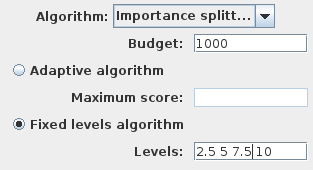This algorithm allows to estimate the probability of rare events (with very low probability) more efficiently than the classical Chernoff-Bound. The idea is to decompose the verification of property \( \phi \) into several properties such that \( \phi_1 \Rightarrow \phi_2 \Rightarrow \phi_3 \Rightarrow \dots \Rightarrow \phi_n=\phi\). These properties defined a set of levels that a trace need to satisfy before \( \phi \) is satisfied.
RML observers
The importance splitting algorithm only works with a special type of requirement from the observer plugin included in the RML plugin. An observer requirement encodes the automata that determines the value of a BLTL property along a trace. If this property can be decomposed the automata computes a score that determines which level has been reached by the trace.
Syntax
An observer is a similar to a module from the RML language with the following particularities:
- An observer is declared with the construction observer … endobserver in place of module … endmodule.
- An observer can declared local variables.
- An observer can reference in its expressions external variables from the model.
- An observer can only have non synchronized commands.
An observer requirement can have several observers, as well as constants, formulas, and global variables. It must contain one variable score and one variable decided.
Important!
As example this observer is used in the simple chain model:
observer chainObserver
score : double init 0;
decided : bool init false;
[] s != 11 & score < s -> (score’=score+1);
[] s>=10 -> (decided’=true);
endobserver
Semantics
The observers are executed in sequentially to the model after each step:
- Each observer in the requirement is executed once in sequential order from top to bottom of the requirement file.
- Each enabled command from an observer is executed once, again sequentially in the order of declaration from top to bottom.
- The observers and the model are simulated as long as the variable decided is false. Therefore the observers must encode a temporal bound and update the variable decided once the temporal bound is exceeded.
- The variable score is used by the algorithm to determine which level the current trace has reached.
From BLTL to observers
Plasma Lab include a tool that can automatically translate a BLTL property into an observer requirements. This functionality is available with a right click on the name of the BLTL property in the Project Explorer. The property can have limited nesting of temporal operators. It produces an observer requirement with several observers (one for each temporal operator). The user must then edit this requirement to compute an adequate score.
Importance Splitting Algorithms
The algorithms principle is specified a fixed budget that is the number of traces executed at each level. The traces that reached the next level are kept. The ones that failed are restarted from a successful trace. The algorithms then compute a series of conditional probabilities to reach a level n from a level n+1 and the final result is the product of these conditional probabilities.
Two different importance splitting algorithms are available in Plasma Lab:
- In the fixed levels algorithm the levels are specified by the user that inputs a series of decimal values separated by spaces. These values correspond to the score of the different levels.

Running the fixed levels algorithm on the simple chain model with 4 levels (2.5, 5, 7.5 and 10)
- In the adaptive algorithm the number of levels is not known a priori. The user input the maximum score of the trace, that is reached when the trace satisfies the BLTL property encoded by the observers.

Running the adaptive algorithm on the simple chain model with a maximum score of 10



